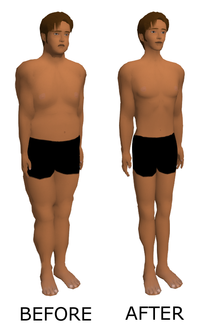
Photo from wikipedia
CONTEXT Exercise-associated hyponatremia (EAH) is a potentially fatal condition that can be prevented by avoiding excessive fluid intake. Running has become more popular in recent years, so it is… Click to show full abstract
CONTEXT Exercise-associated hyponatremia (EAH) is a potentially fatal condition that can be prevented by avoiding excessive fluid intake. Running has become more popular in recent years, so it is important to assess the safety of runners' hydration strategies. OBJECTIVE (1) To explore the intended hydration strategies of a sample of marathon runners before the 2014 London Marathon, (2) to examine their sources of information and knowledge about fluid intake and their understanding of EAH, and (3) to compare these findings with the results of a similar study carried out before the 2010 London Marathon. DESIGN Cross-sectional study. SETTING The 2014 London Marathon. PATIENTS OR OTHER PARTICIPANTS A total of 298 runners (148 males, 150 females), 0.83% of all race finishers. MAIN OUTCOME MEASURE(S) Planned frequency, type, and volume of hydration; sources of information about appropriate drinking; and understanding of hyponatremia were explored. Comparisons were made with data collected from a sample of participants at the 2010 London Marathon. Data relating to the 2014 cohort are presented in descriptive form. Comparisons of the 2010 and 2014 cohorts were conducted using parametric and nonparametric methods. RESULTS A total of 48.7% of the 2014 cohort listed drinking to thirst as the most important factor affecting their hydration strategy during the race. This compared with 25.3% of runners from the 2010 cohort and represented an increase (χ2 = 29.1, P = .001); 5.8% of the 2014 cohort planned on drinking more than 3.5 L, compared with 12% of the 2010 cohort (χ2 = 4.310, P = .038). CONCLUSIONS The number of sampled individuals using thirst to guide hydration strategies in the 2014 London Marathon increased from 2010. However, more than half of the 2014 cohort was not planning to drink to thirst. Runners still need to be educated about the risks of overdrinking as they continue to demonstrate a lack of knowledge and understanding.
Journal Title: Journal of athletic training
Year Published: 2018
Link to full text (if available)
Share on Social Media: Sign Up to like & get
recommendations!